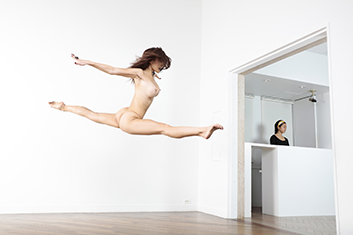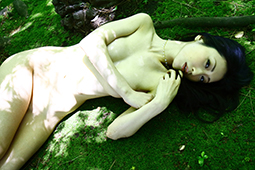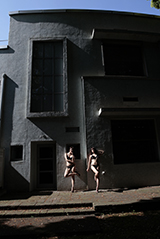 |
Focus features two in-depth reviews each month of fine art, architecture and design exhibitions and events at art museums, galleries and alternative spaces around Japan. The contributors are non-Japanese art critics living in Japan. |
|
|
 |
 |
 |
House of Nudes: Kishin Shinoyama at the Hara Museum
Lucy Birmingham |
 |
 |
|
 |
Think "nudes" and a paradoxical clash of beautiful and pornographic imagery likely comes to mind. At Tokyo's Hara Museum of Contemporary Art, celebrated photographer Kishin Shinoyama is melding and stretching that paradox with an enticing house full of women (and one man) in the flesh -- a show with more than meets the eye.
With his signature frizzy hairstyle and exuberant energy, Shinoyama, 75, is firmly placed among Japan's iconic photographers. His celebrity portraits (John and Yoko included) and groundbreaking nudes reach back to the 1960s, some courting considerable controversy for himself and his models.
His 1991 photo book Santa Fe thrust him and popular teen actress Rie Miyazawa into the front lines of Japan's "hair nude" (i.e. with visible pubic hair) debate. The uproar ultimately helped liberalize the nude photography genre. The showing of pubic hair became acceptable, though genitalia must still remain unseen. The publication is said to be Japan's best-selling photo book of all time.
More recently, Shinoyama has been facing what he says are tighter and tighter regulations. His No Nude by Kishin 20XX, published in 2009, quickly sold out, but has not been reprinted. (The book is now a collector's item.) Media reported that a complaint was issued to police about him photographing nudes in a public cemetery in 2008. He had been previously warned about shooting in public places, said the authorities. Later, police raided his home and office, as well as the models' agencies. In 2010 he was charged and found guilty of "public indecency" and "disrespecting a place of worship." He avoided jail time by admitting guilt, apologizing and paying a ¥300,000 fine.
 |
|
 |
That high-profile case may have turned the shooter a bit gun shy. The Hara Museum -- a former residence offering privacy, 1930s Bauhaus-style Art Deco elegance, and verdant grounds -- must have seemed an ideal location for a combined on-site nude photo shoot and exhibition.
"Shinoyama-san had a very clear vision of what he wanted to do," says Junko Watanabe, the museum's Director of International Programs. Museum Chairman Toshio Hara was surprised at the photographer's proposal, she adds. "We'd never done a nude exhibition or taken photos at the museum for a show where the photographs would be displayed, but Mr. Hara thought it was very unique. It's something that not many museums would allow, so he said ‘Why not!'"
The museum closed its doors for several weeks to allow Shinoyama full freedom to shoot his models throughout the interior and exterior. The result is about
60 larger-than-life prints (all untitled) displayed in the rooms or outside where the models were actually photographed. It's an uncanny visual treat, not only for the intimacy that envelops the viewer, but also the storytelling that emerges.
There are professionals and amateurs among the 33 or so models. Pros include the nice and naughty "gravia (gravure) idols" who appear in men's magazines, such as the uber-popular DanMitsu. High-profile AV joyu (adult video actresses) who crossed the gravia gray zone into porno are also prominent. Topping off the entertainment are pole dancers and athletes demonstrating some eye-popping feats, with pro wrestler Kazuchika Okada leading the men. The amateur models are gathered in the "pink room" where they frolic, drink champagne and play with poodles in a themed scenario featuring a bemused cigar club owner. (Try guessing which one is the owner's wife.)
 |
|
 |
The back room on the second floor reveals a darker side to the show, and to Shinoyama's oeuvre. In one photo an important story appears in the making. A nude model lies on the ground with blood oozing from her mouth, as another crouches over her to help. It seems we are left to speculate on the how and why, led by our own assumptions. But I was keen to get a deeper peek into Shinoyama's purpose.
Another story entices in the exterior photograph taken near the museum entrance. Here a man looks back at us while being lured into the house by a beautiful naked woman. Is his look one of guilt or greeting? Perhaps both. The male model is none other than Toshio Hara (fully dressed), who also greets us in a photo inside the entrance. In this picture, Shinoyama has brilliantly captured the proud and ever-so-slight naughty-boy smile of the master of the house, with three women posing provocatively at his side and feet, au naturel.
Beyond the mystery and titillation, Shinoyama's prints are pure mastery, with superior lighting, skin tones and airbrush technique. Part of his stylistic allure comes from what he calls his "Shino-rama" style of shooting with three cameras simultaneously. It's a play on the word Cinerama, a wide-screen, three-projector process used in movie theaters starting in the 1950s. Interestingly, while their bodies exude perfection, most of the pro models wear faces that are eerily emotionless. While staring up at their frozen, controlled features I quickly thought of Ava, the A.I. humanoid robot in the film Ex Machina.
 |
|
 |
The staff was worried about how viewers would react to the show, and if it would attract perverts. "That hasn't happened at all, and visitors are saying the photos are akarui nudo, a healthy, fun nudity," explains Watanabe. "Many people compare Shinoyama with [Nobuyoshi] Araki. I'm not saying one is better than the other, but their styles are completely different." In fact, the exhibition is attracting elderly couples and even families with young children. "People who have never been to a contemporary art museum before are also coming for a look-see. They're attracted to the beauty of the images, which I think shows the power of Shinoyama's photographs."
All images © Kishin Shinoyama 2016, courtesy of the Hara Museum of Contemporary Art. |
 |
 |
Lucy Birmingham
Lucy Birmingham is a long-time, Tokyo-based journalist, scriptwriter, author, and former photojournalist. She recently served two years as president of the Foreign Correspondents' Club of Japan. She has written regularly for TIME magazine and her articles have appeared in many publications, including the Wall Street Journal, Newsweek, Bloomberg News, and Architectural Digest. As an arts and culture writer her articles have appeared in publications including Artinfo.com, Artforum.com, and ARTnews. She is also a scriptwriter and narrator for NHK (Japan's public broadcaster) and has published several books including Strong in the Rain: Surviving Japan's Earthquake, Tsunami, and Fukushima Nuclear Disaster. lucybirmingham.com |
|
 |
|